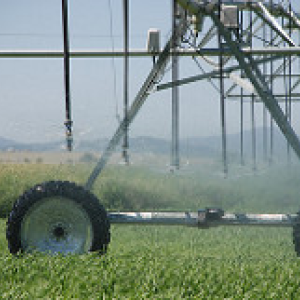
This article examines global overuse of freshwater resources and how more sustainable irrigation practices could impact other environmental and developmental targets in the SDGs. It finds that the main likely effects are 1) increased food prices due to lower productivity and/or production costs as water prices increase, and 2) cropland expansion and associated extra GHG emissions of 0.87 gigatonnes of carbon.
The article used data from the Water Balance Model to create a quantitative model that uses geo-spatial and hydrological information to predict the effects of altering irrigation practices where they are currently unsustainable. One climate scenario was used to consider potential changes in water availability by 2050. Global land was divided into 62,000 cells, and water basins are merged to form sub-basins of 90,000-200,000km2 and 958 basins globally. To calculate the price of water, the authors compared yield gains from irrigated versus rain-fed agriculture, multiplied by FAO crop prices to get an estimate of its value. The authors note that data on local irrigation use and crop production on a global scale are outdated.
The article finds that management in water basins with the aim of water usage sustainability would likely experience food price and malnutrition increases. To avoid this, rainfed cropping would have to expand, or other basins must fill the production gap with their surplus. Crop prices are expected to rise by 0.39% if averaged across a global market as water input costs increase, precipitating a potential decline in calorie consumption. While the increase in prices may seem modest, the authors suggest that this could lead to the malnutrition in 800,000 people.
The model shows that if irrigation is reduced, a compensatory expansion of rainfed cropland may be needed, especially in South Asia and the Middle East and Northern Africa. This agricultural expansion may be as much as 12.7-14.4 Million hectares if all unsustainable irrigation practices are stopped; with environmentally damaging land use change and carbon release into the atmosphere as potential consequences. However, yield gains in irrigated agriculture (and also rainfed to some extent) through technological improvements, could offset this effect. Indeed, a core conclusion of the article is that efficiency gains will be imperative to improving water-use sustainability.
The model predicts that the only basins showing improvement between 2006 and 2050 will be those which are set to receive more rainfall under future climate-change conditions (see figure below).

The article also examines to what extent inter-basin water transfer - in which water is transferred, usually via pipes, from one river basin to another - and an international physical trading market for water might affect agricultultural water use. Large-scale transfers can in fact encourage more unsustainable behaviour as exploitation transcends boundaries. The transfer infrastructure needed for this trade could also be environmentally and socially damaging, as well as expensive. The authors note the importance of integrated rather than segmented commodity markets - that is to say global markets in which barriers to trade are low - as irrigation vulnerable areas would suffer more acutely from volatility if they were isolated or undersupplied.
Abstract
Unsustainable water use challenges the capacity of water resources to ensure food security and continued growth of the economy. Adaptation policies targeting future water security can easily overlook its interaction with other sustainability metrics and unanticipated local responses to the larger-scale policy interventions. Using a global partial equilibrium grid-resolving model SIMPLE-G, and coupling it with the global Water Balance Model, we simulate the consequences of reducing unsustainable irrigation for food security, land use change, and terrestrial carbon. A variety of future (2050) scenarios are considered that interact irrigation productivity with two policy interventions— inter-basin water transfers and international commodity market integration. We find that pursuing sustainable irrigation may erode other development and environmental goals due to higher food prices and cropland expansion. This results in over 800 000 more undernourished people and 0.87 GtC additional emissions. Faster total factor productivity growth in irrigated sectors will encourage more aggressive irrigation water use in the basins where irrigation vulnerability is expected to be reduced by inter-basin water transfer. By allowing for a systematic comparison of these alternative adaptations to future irrigation vulnerability, the global gridded modeling approach offers unique insights into the multiscale nature of the water scarcity challenge.
Reference
Liu, J., Hertel, T.W., Lammers, R.B., Prusevich, A., Baldos, U.L.C., Grogan, D.S. and Frolking, S., 2017. Achieving sustainable irrigation water withdrawals: global impacts on food security and land use. Environmental Research Letters, 12(10), p.104009.
For a full version of the article, see here (open access).







Post a new comment »